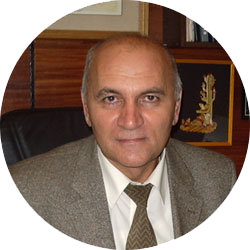RF Patent # 2088539. Filed 31.05.1995, published 27.08.1997
Bakhir V.M., Zadorozhny Yu.G., Barabash T.B.
STEL device for production of electrochemically activated sterilizing, disinfectant and washing solution for the first time implements technological process of producing anolyte known as ANK. The first stage of the technological process of ANK production includes cathodic treatment of the whole bulk of initial sodium chloride solution, and after solution’s leaving the reactor’s cathodic chamber the second stage is carried out – separation of part of catholyte and hydrogen bubbles with adherent particles of heavy metal hydroxides, after which catholyte saturated with dissolved hydrogen and cleared from heavy metal ions undergoes subsequent treatment in the anode of the same electrochemical reactor. Technological process of ANK anolyte production realized in the given device is very simple and allows to produce efficient antimicrobial and washing solution in a flow-through diaphragm-type electrochemical reactor in the absence of differential pressure on diaphragm. According to a diaphragm classification well known in applied electrochemistry, diaphragm used in the process of ANK anolyte production is called submersible, that is, working in conditions of no differential pressure. On the contrary, electrochemical reactor diaphragm working under differential pressure is called filtration one. The seeming simplicity of the technological process is deceptive. For instance, in the course of ANK anolyte testing in the Research Institute of Disinfectology of the Ministry of Health of the Russian Federation (VNIID) and practical application of the first STEL devices in Russian medical facilities, experts in producing sodium hypochlorite in non-diaphragm electrolyzers had a lot of questions: “In the process of ANK anolyte production both cathodic and anodic treatment of initial salt solution take place, same as in non-diaphragm electrolyzers. What is the principal difference between the solutions obtained? Is ANK anolyte with рН about 7 a hypochlorite solution? Can ANK anolyte be produced by adding a small amount of hydrochloric or some other acid to alkaline (with рН above 8) sodium hypochlorite solution? Can ANK anolyte be produced by mixing anolyte with some catholyte? Why is ANK anolyte’s bactericidal ability 300 times higher than that of sodium hypochlorite solution, when oxidant (active chlorine) concentration is the same? Why does sodium hypochlorite solution have no sporicidal power at any concentrations, whereas ANK anolyte kills all existing spores and is sterilizing (i.е., eradicating all microorganism species and forms) at a concentration as low as 50 mg/l?” Answers to these questions are rather simple, but in the given paper they are only outlined and cannot be completely disclosed. The point is that in spite of subjecting initial solution to both cathodic and anodic treatment in the process of ANK anolyte production the principle of electrochemical exposure unipolarity is very strictly observed and realized by separating the processes of opposite-polar electrochemical treatment of the same portion of the solution in space and in time. When initial salt solution flows through the cathodic chamber of reactor, some part of chlorine ions is removed from it through the diaphragm due to electromigration. With oncoming movement through the diaphragm, sodium ions transport electric charge from solution flowing in the anodic chamber. Thus, under the action of electric current, during solutions’ flow through electrode chambers, there occurs fixation of increased (as compared to initial solution) sodium ion concentration in cathode chamber and increased (also in comparison to initial solution) chlorine ion concentration in anode chamber. After removing part of sodium ions along with a solution of mixed sodium, magnesium, calcium and iron hydroxides in a flotation reactor, solution containing sodium ions at a concentration lower than that of initial solution is fed into the reactor’s anodic chamber. The excess of chloride-ions in anodic chamber results in that they are the first to oxidize on the anode forming chlorine-oxygen compounds in ANK anolyte, and their concentration surpasses the concentration of salt formed in the equivalent quantity during chemical (or electrochemical – in non-diaphragm reactor) interaction of molecular chlorine with sodium hydroxide solution. This chemical instability of ANK anolyte is the most important factor of its biocidal activity. Achieving as high chemical instability of a solution as possible depends on many factors, in particular, on physical and chemical properties of electrochemical reactor diaphragm, its size, shape, ratio of dimensions of principal components of reactor’s electrode chambers, initial solution flow rate, salt content, current density and many other factors. At the present moment, over 30,000 STEL devices producing ANK anolyte operate in Russian medical facilities. However, many of these devices are imitations and cannot produce the kind of anolyte the authors meant. It happens because smart suppliers and manufacturers of fake STEL devices pay attention only to outward attributes of original technology and devices for its implementation, but provide their articles with official papers received after testing the original devices. It is extremely difficult to tell a fake device from a real one, especially for uninformed consumers. There are several companies having no legal rights to manufacture devices producing ANK anolyte, such as “Aquastel” company registered in Estonia and manufacturing “Aquastel” and “Eurostel” devices with reactors that do not violate the patent law, as they do not resemble FEM-1, FEM-2, and FEM-3 modules in their appearance, but cannot produce proper-quality ANK anolyte; “Perspektiva” company from Dubna, Moscow region, manufacturing fake FEM-3 modules, whose unsatisfactory work causes consumers’ complaints, as well as some other companies and individuals.
